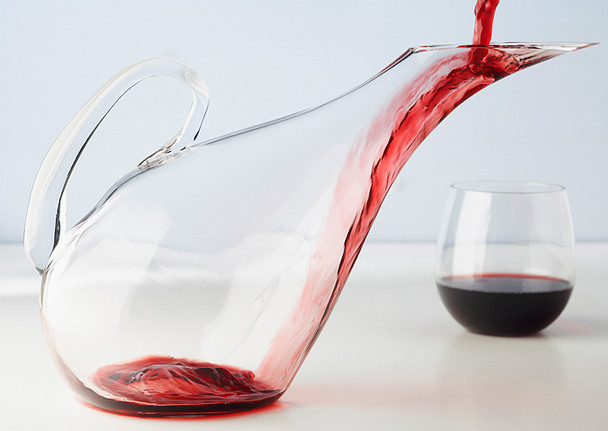Got wine? There's a good chance you do. America has been steadily increasing its wine consumption every year for the past three decades, going from 480 million gallons consumed in the United States in 1980 to 784 million gallons in 2010, according to the Wine Institute, an advocate for California wineries. Today, Chardonnay, Merlot, Cabernet Sauvignon, and other varietals, not to mention wine regions near and far—Burgundy, Chianti, Carneros—roll off our tongues as easily as Starbucks coffee orders. Wine refrigerators are increasingly common in high-end home kitchens these days, and some of us even have temperature-controlled wine cellars.
But do you decant your wine before serving it? Do you even need to? Is it some lifted-pinky holdover from stuffy Continental restaurants, or the cheapskate's way to mask an inexpensive wine?
In the simplest terms, decanting means to pour wine from the bottle into another container—usually a glass vessel with a wide bottom and plenty of air space, but even a wineglass can serve as a decanter. The main purpose of decanting is to allow the wine to "breathe" by interacting with oxygen. This aeration allows the wine's flavor to develop and lets the fragrance "blossom," as Andrea Immer Robinson, a Master Sommelier and author of Great Wine Made Simple, explains. Aside from letting the wine breathe, decanting helps separate the wine from sediments that can develop while the wine is aging. "And that's a big deal," notes Robinson, "because you don't want to drink crunchy wine." (To separate out the sediments, illuminate the neck of the bottle with a candle while slowly pouring the wine into the decanter, so you can stop the flow when you see dark specks.)
We spoke to Robinson, as well as several sommeliers and restaurant beverage directors and a winery founder, and all believe that decanting can indeed make a difference in how a wine tastes. Cat Silirie, the wine director for the Barbara Lynch Gruppo in Boston, which includes No. 9 Park, the 2012 James Beard Award winner for outstanding wine program, is positively poetic about the procedure. "Most wines…are known to enjoy mingling with oxygen after having been corked up! The newly freed vino thus unfurls its charms by being poured from one container to the next for an invigorating rendezvous with aeration."
In fact, you've probably already experienced what decanting can do without even realizing it, explains Belinda Chang, beverage director of the Culinary Concepts Hospitality Group, a New York–based company that licenses and operates high-end restaurant brands around the world. "You go to dinner and you order this red wine and the first glass is like, 'Eh, it's OK,' and then as you go through and get almost to the last drop, you're like, 'Wow, that's the greatest I've ever had, it's changed so much!'" In effect, the wine, although not decanted, has been exposed to air in the open bottle and in the glass, helped along with an occasional swirl or two.
Robinson says decanting mimics what happens when wine is aged in a cellar and experiences a "super-slow-slow-slow oxidation process through the pores of the cork," allowing tannins and other components to soften: "It's the next best thing to having the time, patience, money, and wherewithal to put aside wine in a cellar and then wait for it to smooth out when it's ready."
But while these authorities recognize the advantages of decanting, they definitely don't advocate it for all wines, and they vary in their recommendations of which wines should be decanted and for how long. Robinson is all for decanting young full-bodied reds, for example, because their tannins can be intense. The aeration "softens the grip of tannin so that the fruit and the other complexities can emerge."
For Daniel Johnnes, wine director of Daniel Boulud's Dinex Group, decanting is generally recommended, but because each wine is unique, it's the sommelier's job to make the judgment. "Most people think sommeliers are glorified waiters walking around the dining room pulling a cork and serving," he says, but "there's actually a lot you have to know." Some wines are decanted right away so that they can breathe for a half hour, while others get five minutes. For some of the great old red wines, just the act of pouring into big-bowled wineglasses is aeration enough, Johnnes maintains. More than that, and these wines could rapidly fade.
But not all aged reds get that minimal treatment. Chang recalls restaurants in Piedmont, Italy, where you order a grand, aged Barolo the night before so that the wine can be decanted several hours before you arrive.
Randall Grahm, founder and self-described "president-for-life" of the Santa Cruz–based Bonny Doon Vineyard, believes that wines fall into two categories: those that need or don't need decanting. What he considers "real wines"—ones that have an aspect of minerality, or "life force" (often from Europe, where they are grown in mineral-rich soils, without irrigation)—are "closed," according to Grahm, when the bottles are first opened up. However, they change dramatically after they've been exposed to air for a while.



 Pinterest
Pinterest


